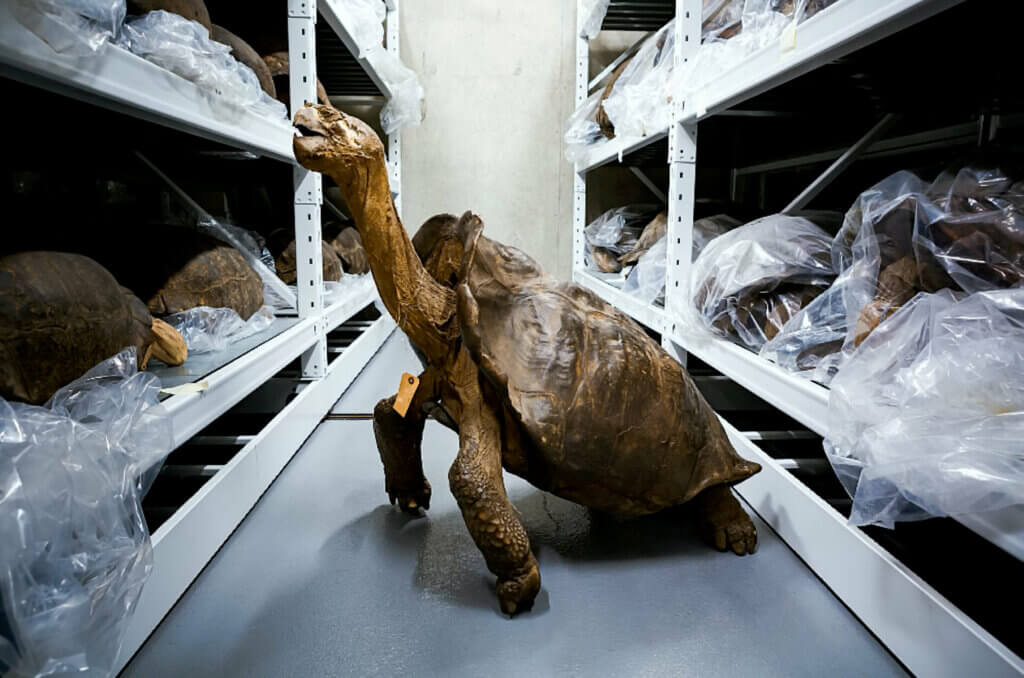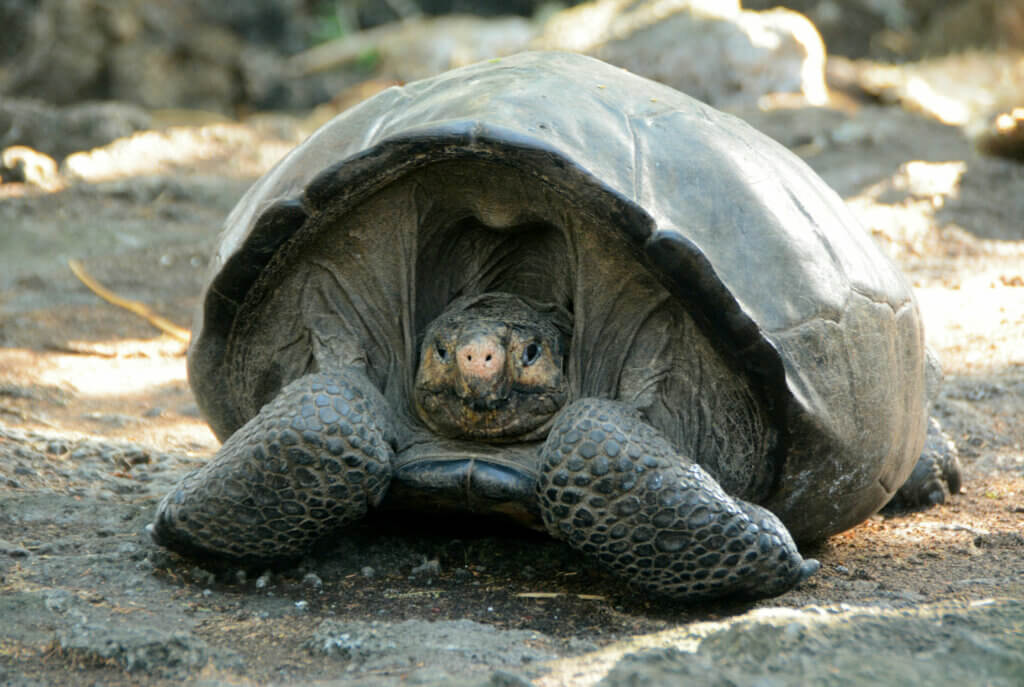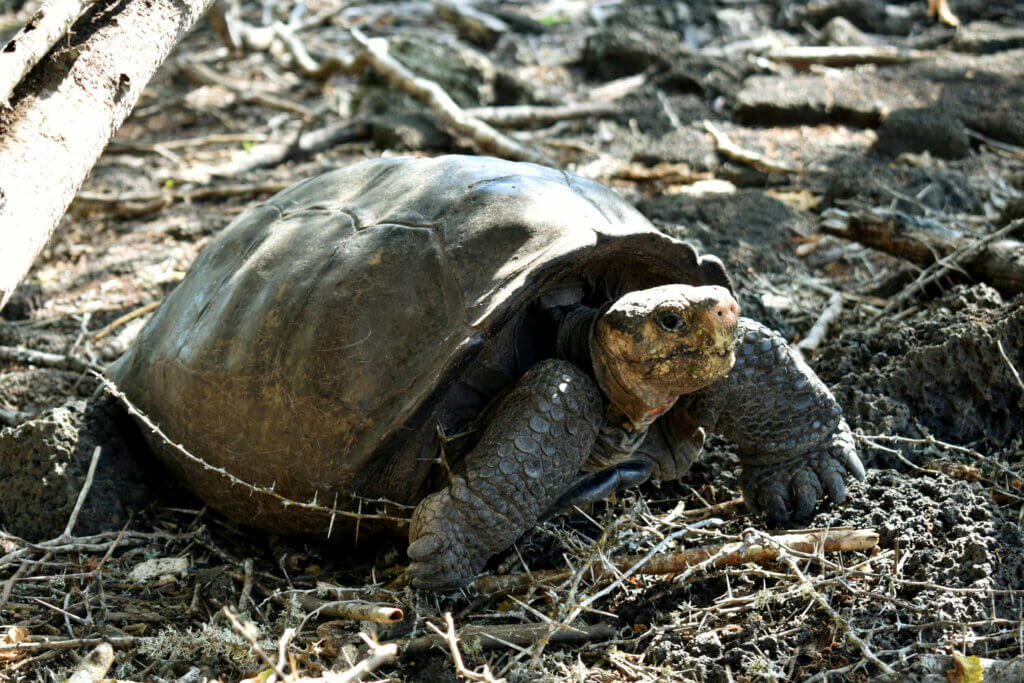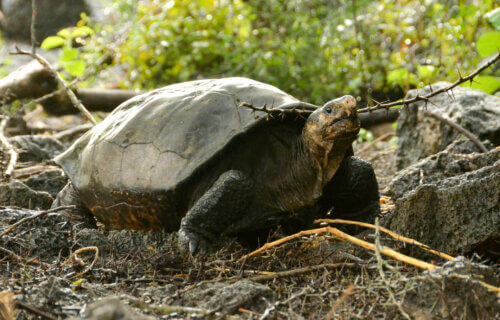PRINCETON, N.J. — A species of tortoise long believed extinct has been found alive and well on the Galápagos Islands. The reptile, named “Fernanda” after her Fernandina Island home, is the first of her species identified in more than 100 years.
The Fernandina Island Galápagos giant tortoise — Chelonoidis phantasticus, or “fantastic giant tortoise” — was known only from a single specimen, collected in 1906. However, the discovery in 2019 of a female tortoise living on Fernandina Island provided the chance to determine if the species still exists.
By sequencing the genomes of both the living individual and the museum specimen, and comparing them to the other 13 species of Galápagos giant tortoises, co-first author Dr. Stephen Gaughran, of Princeton University, showed that the two known Fernandina tortoises are members of the same species, genetically distinct from all others. Gaughran, a postdoctoral research fellow in ecology and evolutionary biology, thus confirmed the species’ continued existence.

“For many years it was thought that the original specimen collected in 1906 had been transplanted to the island, as it was the only one of its kind. It now seems to be one of a very few that were alive a century ago,” says Peter Grant, a Princeton professor who has spent more than 40 years studying evolution in the Galápagos islands, in a statement.
He explains that when Fernanda was discovered, many ecologists doubted that she was actually a native phantasticus tortoise, as she lacks the striking “saddleback” flaring of the male historical specimen. Scientists speculated, however that her obviously stunted growth may have distorted her features.
Tortoises can’t swim from one island to another, but they do float, and they can be carried from one Galápagos island to another during hurricanes or other major storms. There are also historical records of seafarers moving the tortoises between islands. “Like many people, my initial suspicion was that this was not a native tortoise of Fernandina Island,” says Dr. Gaughran.
To determine Fernanda’s species definitively, he sequenced her complete genome and compared it to the genome he was able to recover from the specimen collected in 1906. He also compared those two genomes to samples from the other 13 species of Galápagos tortoises – three individuals from each of the 12 living species, and one individual of the extinct C. abingdonii.

“We saw – honestly, to my surprise – that Fernanda was very similar to the one that they found on that island more than 100 years ago, and both of those were very different from all of the other islands’ tortoises,” says Dr. Gaughran.
Adds study senior author Adalgisa Caccone, from Yale University: “The finding of one alive specimen gives hope and also opens up new questions, as many mysteries still remain. Are there more tortoises on Fernandina that can be brought back into captivity to start a breeding program? How did tortoises colonise Fernandina, and what is their evolutionary relationship to the other giant Galápagos tortoises? This also shows the importance of using museum collections to understand the past.”
Gaughran says that part of his work at Princeton involves creating a tool that can analyze DNA from specimens seen in museums for comparison to samples still found today. “The software doesn’t care if it’s a seal or a tortoise or human or Neanderthal. Genetics is genetics, for the most part. It’s in the interpretation where it matters what kind of creature the DNA comes from,” he says
Since 1906, scant but compelling evidence has hinted that giant tortoises might still live on Fernandina Island, an active volcano on the western edge of the Galápagos Archipelago that is reputed to be the largest “pristine” island on Earth. A single specimen of C. phantasticus was collected by explorer Rollo Beck during a 1906 expedition.
The “fantastic” nature of its name refers to the extraordinary shape of the males’ shells, which have extreme flaring along the outer edge and conspicuous saddlebacking at the front. Saddlebacking is unique to Galápagos tortoises, and the phantasticus tortoise shows it more prominently than the other species.
Since its 1906 discovery, the survival of the Fernandina tortoise has remained an open question for biologists. The island has remained largely unexplored, due to extensive lava fields blocking access to the island’s interior. Scientists estimate that Fernanda is well over 50 years old, but she is small, possibly because the limited vegetation stunted her growth.

Gaughran says the tortoise populations were decimated by European seafarers who hunted them for food. They discovered that they could keep tortoises alive on their ships with minimal effort, as the reptiles could survive with little food or water. “They were a great source of fresh meat for the sailors, but it meant that many of the species were severely overhunted,” he says. “And because they have such a long generation time, the populations have a hard time recovering quickly.”
Adds Grant: “The genetic work provides intriguing hints of a mixing of genes with members of another population. It would be fascinating if confirmed by future detective work on the genome. Another thought-provoking finding is the nearest relatives are not on the nearest very large island, Isabela, but on another, Española, far away on the other side of Isabela. The question of how the ancestors reached Fernandina is left hanging.”
Fernanda is now at the Galápagos National Park Tortoise Center, a rescue and breeding facility, where experts are seeing what they can do to keep her species alive.
“The discovery informs us about rare species that may persist in isolated places for a long time,” Grant notes. “This information is important for conservation. It spurs biologists to search harder for the last few individuals of a population to bring them back from the brink of extinction.”
The research is published in the journal Communications Biology.
Report by South West News Service writer Stephen Beech.
